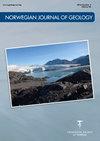求助PDF
{"title":"挪威中部二叠纪-三叠纪沉积充填与构造阶段:Trøndelag台地的地震调查","authors":"E. B. Kiswaka, M. Felix","doi":"10.17850/njg100-2-3","DOIUrl":null,"url":null,"abstract":"Kiswaka, E.B. & Felix, M. 2020: Permo–Triassic sedimentary fills and tectonic phases off Mid Norway: seismic investigation of the Trøndelag Platform. Norwegian Journal of Geology 100, 202009. https://dx.doi.org/10.17850/njg100-2-3. © Copyright the authors. This work is licensed under a Creative Commons Attribution 4.0 International License. Seismic interpretation (2D and new 3D surveys) has been used to investigate sedimentary fills and timing of tectonic activity offshore Mid Norway. This study was focused on upper Permian and Lower Triassic sedimentary basin fills, but a longer stratigraphic interval (Devonian–Upper Triassic) was analysed in order to get a broad understanding of what happened prior to, during and after deposition of the upper Permian–Lower Triassic successions. The ages of the sedimentary fills were partly constrained by well ties. Seismic reflectors and sedimentary successions below the upper Permian interval are of Late Devonian– mid Permian age. Six sedimentary fill geometries (fill type A – F) were identified. These are (A) fault-ward thickening packages with internal strata thickening towards bounding faults, (B) wedge-shaped packages whose internal strata have more or less uniform thickness, (C) sedimentary fills containing fill type A overlain by sedimentary strata with more or less uniform thickness, (D) gently dipping packages that thicken towards deeper areas of the basin, and downlap onto pre-existing topography, (E) gently dipping strata filling depressions, and (F) sedimentary wedge with rotated internal strata and folded top. These fill types were used to determine phases of active tectonics and quiescent phases. Based on temporal changes of the fill types, five late Palaeozoic–Triassic unconformities have been mapped: a nonconformity where the Palaeozoic strata onlap onto the basement, a mid-Permian unconformity, two Early Triassic unconformities and a Middle Triassic angular unconformity. Results show that Devonian– Permian, mid-Permian, latePermian, Early Triassic, late Early Triassic, and Mid–Late Triassic rifts influenced","PeriodicalId":49741,"journal":{"name":"Norwegian Journal of Geology","volume":" ","pages":""},"PeriodicalIF":0.8000,"publicationDate":"2020-07-08","publicationTypes":"Journal Article","fieldsOfStudy":null,"isOpenAccess":false,"openAccessPdf":"","citationCount":"8","resultStr":"{\"title\":\"Permo–Triassic sedimentary fills and tectonic phases off Mid Norway: seismic investigation of the Trøndelag Platform\",\"authors\":\"E. B. Kiswaka, M. Felix\",\"doi\":\"10.17850/njg100-2-3\",\"DOIUrl\":null,\"url\":null,\"abstract\":\"Kiswaka, E.B. & Felix, M. 2020: Permo–Triassic sedimentary fills and tectonic phases off Mid Norway: seismic investigation of the Trøndelag Platform. Norwegian Journal of Geology 100, 202009. https://dx.doi.org/10.17850/njg100-2-3. © Copyright the authors. This work is licensed under a Creative Commons Attribution 4.0 International License. Seismic interpretation (2D and new 3D surveys) has been used to investigate sedimentary fills and timing of tectonic activity offshore Mid Norway. This study was focused on upper Permian and Lower Triassic sedimentary basin fills, but a longer stratigraphic interval (Devonian–Upper Triassic) was analysed in order to get a broad understanding of what happened prior to, during and after deposition of the upper Permian–Lower Triassic successions. The ages of the sedimentary fills were partly constrained by well ties. Seismic reflectors and sedimentary successions below the upper Permian interval are of Late Devonian– mid Permian age. Six sedimentary fill geometries (fill type A – F) were identified. These are (A) fault-ward thickening packages with internal strata thickening towards bounding faults, (B) wedge-shaped packages whose internal strata have more or less uniform thickness, (C) sedimentary fills containing fill type A overlain by sedimentary strata with more or less uniform thickness, (D) gently dipping packages that thicken towards deeper areas of the basin, and downlap onto pre-existing topography, (E) gently dipping strata filling depressions, and (F) sedimentary wedge with rotated internal strata and folded top. These fill types were used to determine phases of active tectonics and quiescent phases. Based on temporal changes of the fill types, five late Palaeozoic–Triassic unconformities have been mapped: a nonconformity where the Palaeozoic strata onlap onto the basement, a mid-Permian unconformity, two Early Triassic unconformities and a Middle Triassic angular unconformity. Results show that Devonian– Permian, mid-Permian, latePermian, Early Triassic, late Early Triassic, and Mid–Late Triassic rifts influenced\",\"PeriodicalId\":49741,\"journal\":{\"name\":\"Norwegian Journal of Geology\",\"volume\":\" \",\"pages\":\"\"},\"PeriodicalIF\":0.8000,\"publicationDate\":\"2020-07-08\",\"publicationTypes\":\"Journal Article\",\"fieldsOfStudy\":null,\"isOpenAccess\":false,\"openAccessPdf\":\"\",\"citationCount\":\"8\",\"resultStr\":null,\"platform\":\"Semanticscholar\",\"paperid\":null,\"PeriodicalName\":\"Norwegian Journal of Geology\",\"FirstCategoryId\":\"89\",\"ListUrlMain\":\"https://doi.org/10.17850/njg100-2-3\",\"RegionNum\":4,\"RegionCategory\":\"地球科学\",\"ArticlePicture\":[],\"TitleCN\":null,\"AbstractTextCN\":null,\"PMCID\":null,\"EPubDate\":\"\",\"PubModel\":\"\",\"JCR\":\"Q2\",\"JCRName\":\"Earth and Planetary Sciences\",\"Score\":null,\"Total\":0}","platform":"Semanticscholar","paperid":null,"PeriodicalName":"Norwegian Journal of Geology","FirstCategoryId":"89","ListUrlMain":"https://doi.org/10.17850/njg100-2-3","RegionNum":4,"RegionCategory":"地球科学","ArticlePicture":[],"TitleCN":null,"AbstractTextCN":null,"PMCID":null,"EPubDate":"","PubModel":"","JCR":"Q2","JCRName":"Earth and Planetary Sciences","Score":null,"Total":0}
引用次数: 8
引用
批量引用
Permo–Triassic sedimentary fills and tectonic phases off Mid Norway: seismic investigation of the Trøndelag Platform
Kiswaka, E.B. & Felix, M. 2020: Permo–Triassic sedimentary fills and tectonic phases off Mid Norway: seismic investigation of the Trøndelag Platform. Norwegian Journal of Geology 100, 202009. https://dx.doi.org/10.17850/njg100-2-3. © Copyright the authors. This work is licensed under a Creative Commons Attribution 4.0 International License. Seismic interpretation (2D and new 3D surveys) has been used to investigate sedimentary fills and timing of tectonic activity offshore Mid Norway. This study was focused on upper Permian and Lower Triassic sedimentary basin fills, but a longer stratigraphic interval (Devonian–Upper Triassic) was analysed in order to get a broad understanding of what happened prior to, during and after deposition of the upper Permian–Lower Triassic successions. The ages of the sedimentary fills were partly constrained by well ties. Seismic reflectors and sedimentary successions below the upper Permian interval are of Late Devonian– mid Permian age. Six sedimentary fill geometries (fill type A – F) were identified. These are (A) fault-ward thickening packages with internal strata thickening towards bounding faults, (B) wedge-shaped packages whose internal strata have more or less uniform thickness, (C) sedimentary fills containing fill type A overlain by sedimentary strata with more or less uniform thickness, (D) gently dipping packages that thicken towards deeper areas of the basin, and downlap onto pre-existing topography, (E) gently dipping strata filling depressions, and (F) sedimentary wedge with rotated internal strata and folded top. These fill types were used to determine phases of active tectonics and quiescent phases. Based on temporal changes of the fill types, five late Palaeozoic–Triassic unconformities have been mapped: a nonconformity where the Palaeozoic strata onlap onto the basement, a mid-Permian unconformity, two Early Triassic unconformities and a Middle Triassic angular unconformity. Results show that Devonian– Permian, mid-Permian, latePermian, Early Triassic, late Early Triassic, and Mid–Late Triassic rifts influenced


